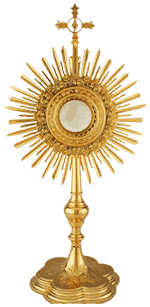 Monday, June 29, is the Solemnity of Sts. Peter and Paul. And it is an important day for the Church Universal as well as for our new Metropolitan Archbishop, the Most Reverend Gregory Aymond. On that date he will be at the Basilica of St. Peter at the Vatican to receive a very special vestment from His Holiness, Pope Benedict XVI. The vestment is called a “pallium,”
Monday, June 29, is the Solemnity of Sts. Peter and Paul. And it is an important day for the Church Universal as well as for our new Metropolitan Archbishop, the Most Reverend Gregory Aymond. On that date he will be at the Basilica of St. Peter at the Vatican to receive a very special vestment from His Holiness, Pope Benedict XVI. The vestment is called a “pallium,”
(plural is “pallia”) and it is a narrow band of cloth woven of white lamb’s wool with a ring in the center which rests on the shoulders of its wearer. The narrow band falls down the front of the chest like a necktie and goes similarly down the back. It is decorated with six black crosses, one on each tail and four on the loop.
The pallium has its origin as a liturgical vestment of the Holy Father since at least the 4th century, and it has been given to each Metropolitan Archbishop since at least the 9th century.
The shape and size of the pallium has changed over the centuries. The pallium of the sixth century was a long, moderately wide, white band of wool, ornamented at its extremities with a black or red cross, and finished with tassels. It was draped around the neck, shoulders, and breast to form a V in front, and the ends hung down from the left shoulder, one in front and one behind. In the eighth century it became customary to let the ends fall down, one in the middle of the breast and the other in the middle of the back, and to fasten them there with pins. The present circular form originated in the 10th or 11th century. Two early examples are preserved in the Archdiocese of Cologne. The two vertical bands of the circular pallium were very long until the 15th century, but were later repeatedly shortened until they now have a length of only about twelve inches.
Worn by the pope, the pallium symbolizes the plenitudo pontificalis officii (i.e., the “fullness of Pontifical office”). When worn by Metropolitan Archbishops, it signifies the power which the Metropolitan, in communion with the Roman Church, has by law in his own province.
The liturgy for the conferral of the pallium provides for its bestowal at the beginning of the Mass in which the Archbishop takes possession of his Archdiocese. However, the recent practice of Pope John Paul II and Pope Benedict XVI has been to summon the new Metropolitans to Rome to receive the pallium directly from the hands of the Holy Father.
The story of how the pallium is made gives clues to its symbolism. The wool comes from lambs raised by Trappist monks. On, January 21, the Feast of St. Agnes (“agnes” is from the Latin word for lamb), the lambs whose wool is destined for the making of the pallia are solemnly blessed at the Basilica of Saint Agnes. However, during the last three years, the Holy Father has blessed these lambs himself at the Vatican. Wool from these lambs is then given to the Benedictine nuns of the Basilica of St Cecilia in Trastevere, and they weave the pallia. The new pallia are solemnly blessed at the Basilica of St. Peter after the Second Vespers on the feast of Sts. Peter and Paul, and are then stored in a special golden chest located directly above the original tomb of St. Peter. It is called the “Niche of the Pallia.”
Because they are made of wool, the symbolism of the pallium is connected to the figure of the Good Shepherd carrying the lamb on his shoulders, so common in early Christian art. And since the pallia sit over the Tomb of St. Peter and are worn jointly by the Holy Father and the Metropolitan Archbishops, their distribution symbolizes the unity of the Church (with the Successor of Peter) and the universality of the Church (as the Archbishops go out to the entire world to spread the Gospel).  At present only the Pope and Metropolitan Archbishops wear the pallium. No other bishops, even non-metropolitan Archbishops or retired Metropolitans, are allowed to wear the pallium unless they have special permission.
If you’re ever at St Louis Cathedral on a Sunday, notice the Archbishop’s pallium. It’s a great reminder of the universality and long history of our Church.




